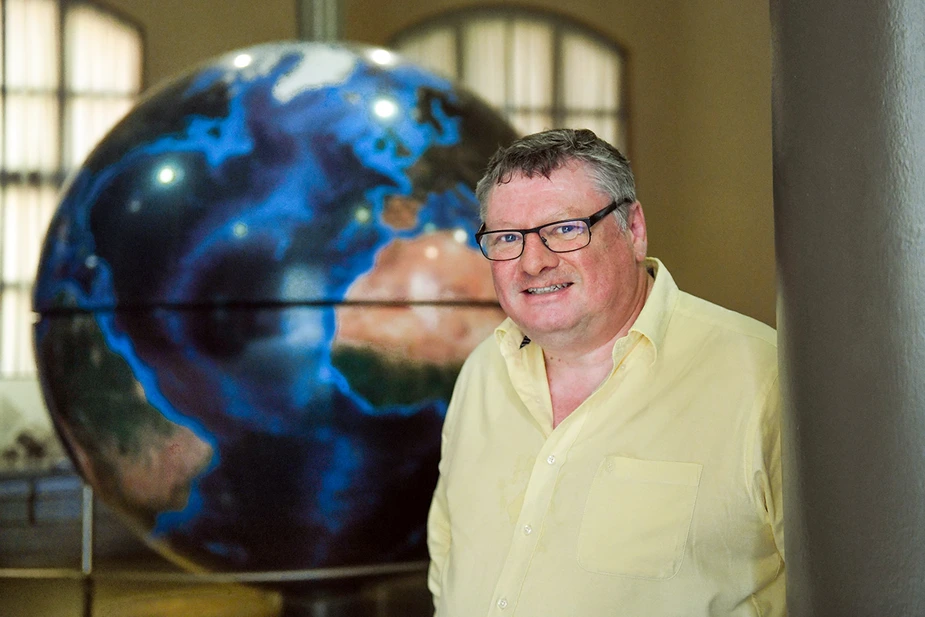Of wild numbers and snapshots in space
Two natural scientists told us how they carry their scientific insight out into the world
Colourful experiments, spectacular images, and elegant equations. There are countless ways of communicating insights from the natural sciences to the general public. But what applies to the applied natural sciences can’t always be said for fundamental research. When it comes to communicating knowledge, every discipline has its own pitfalls and opportunities. We spoke to Jürg Kramer from the Department of Mathematics of Humboldt-Universität zu Berlin and Ulrich Köhler from the Institute for Planetary Research at the German Aerospace Center (DLR) about the language in their field, the exciting moments when communication works, and the limits of what can be made visible.
Christmas, 1968: all of a sudden, the glowing blue earth rises behind the hostile landscape of the cratered moon, and Bill Anders, crew member of the Apollo 8 mission, releases the shutter. ‘Earthrise’ is the apt title of this seminal picture, depicting earth as a vulnerable planet surrounded by a black void for the first time. Top-level research spanning decades, highly complex calculations, and experiments that costed millions were thus condensed into a single image. ‘This is a great example for the power that an iconic photo has,’ says Ulrich Köhler of DLR enthusiastically. ‘The fact that we, as planetary researchers, can work with images – back then it was the moon, today it’s Mars – is lucky for us. If it wasn’t for these images, it would be very hard to communicate to the public what it is we work on.’
In addition to spectacular space photography, Köhler and his team of planetary researchers often approach phenomena that are, strictly speaking, impossible to visualise. One example is dark matter - an invisible type of particle that interacts with the gravity fields of planets. ‘The former director of my institute used to say that while it’s possible to simplify things to a certain extent, the Einsteinian curved space will always be that, a curved space. It’s simply not simplifiable – the heart of the matter will just get lost.’ Faced with an infinitely expanding universe, it was clear that human imagination had its limits. ‘What existed before? What goes on after the universe? This is where we start touching upon theology and philosophy.’
To Jürg Kramer, a professor of mathematics, the difficulties of communicating abstract knowledge are also well known. Images, objects, videos, or sound recordings used to support the knowledge transfer process are scarce in theoretical mathematics, and so he and his colleagues must resort to using numbers and language. The mathematician sees it like it is: ‘I don’t really have a preference when it comes to the way we communicate. The important thing is to create an understanding – and to use the right means to do so.’ He would also use formulas, for example, because they helped to succinctly describe complicated processes. ‘They are essentially compact summaries of facts, making them easier to grasp. Look at the pandemic, for example. In the beginning, the increase in infections was pretty much exactly proportional to the number of infected people and could be easily described with an exponential function.’ These functions were later used to create colourful graphs much like the ones found on the websites of Robert Koch Institute or the Johns Hopkins Coronavirus Resource Center.
Mathematical analysis had another significant strength, the researcher says, and that is to be precise in highlighting small differences. When seeking a solution for a problem, however, it is important, first, to determine whether there is a solution at all – and if there is, whether it is one, several, or an infinite number. ‘Language is an indispensable tool here. We wouldn’t get anywhere without it.’ In addition to its precision, the world of numbers also very much had a chaotic side to it that is not quite as obvious, says Jürg Kramer, calling it ‘a language that interacts with order and proliferation’. One example: ‘We learn at school that fraction numbers either terminate or repeat, when, in fact, most of them don’t terminate – or do not follow any pattern at all.’ Computed to 30 billion decimal places to date, pi is probably the most prominent of these infinite numbers. The mathematics jargon calls pi and her ‘wild sisters’ transcendental numbers – in other words, numbers whose properties exceed common-sense explanations and perceptions.
When it comes to communication, applied planetary research and mathematics have something in common despite their differences: they seek truth and structure, and aim to show the world how it is, touching upon fundamental questions of humanity – and tend to exceed the limits of imagination, whether in the incalculable small space of numbers or in the infinite vastness of the universe. ‘Could be that out research spills over into theology or philosophy at this point. But maybe that’s a good thing,’ says Ulrich Köhler with a wink. ‘You wouldn’t need us if we knew everything already.’
By Nora Lessing for Adlershof Journal

